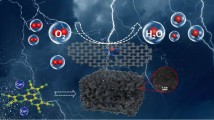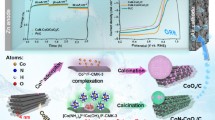Abstract
The development of cathode materials with high cost-effectiveness, reliable performance, and good oxygen reduction activity are important to develop the next generation rechargeable metal-air battery system. Herein, we have developed a novel technique for synthesizing a catalyst with superior activity and durability for oxygen reduction reaction (ORR). Porous carbon with doped Cu nanoparticles was prepared by pyrolyzing Cu-containing ZIF-67 (Cu/ZIF-67). The findings show that Cu0.5%/Co-NC-900 exhibits superior ORR performance with an onset potential (Eo) of 0.98 V and a half-wave potential (E1/2) of 0.85 V, superior to all other prepared as well commercial Pt/C (20 wt.%, Eo 0.96 V and E1/2 0.82 V) catalysts in an alkaline solution. The excellent ORR performance of Cu0.5%/Co-NC-900 is due to the synergistic contribution to gradual mass transfer of Cu, Co and N doping structure, high pyridine content, and porous multilayer structure. This novel and rational metal doping strategy will dramatically enhance electrocatalyst operation and provide a template for new metal-doped porous carbon or catalyst designs.










Similar content being viewed by others
References
L.M. Aguirre-Díaz et al., Group 13th metal-organic frameworks and their role in heterogeneous catalysis. Coord. Chem. Rev. 335, 1–27 (2017)
M. Alves, R. Méreau, B. Grignard, C. Detrembleur, C. Jérôme, T. Tassaing, DFT investigation of the reaction mechanism for the guanidine catalyzed ring-opening of cyclic carbonates by aromatic and alkyl-amines. RSC Adv. 7(31), 18993–19001 (2017)
A. Banerjee, U. Singh, V. Aravindan, M. Srinivasan, S. Ogale, Synthesis of CuO nanostructures from Cu-based metal-organic framework (MOF-199) for application as anode for Li-ion batteries. Nano Energy 2(6), 1158–1163 (2013)
S. Bhunia et al., Efficacious Electrochemical Oxygen Evolution from a Novel Co(II) Porphyrin/Pyrene-Based Conjugated Microporous Polymer. ACS Appl. Mater. Interfaces 11(1), 1520–1528 (2019)
K. Chen, C. De Wu, Designed fabrication of biomimetic metal-organic frameworks for catalytic applications. Coord. Chem. Rev. 378, 445–465 (2019)
C. Chu, S. Rao, Z. Ma, H. Han, Copper and cobalt nanoparticles doped nitrogen-containing carbon frameworks derived from CuO-encapsulated ZIF-67 as high-efficiency catalyst for hydrogenation of 4-nitrophenol. Appl. Catal. B Environ. 256, 117792 (2019)
J.A. Darr, J. Zhang, N.M. Makwana, X. Weng, Continuous Hydrothermal Synthesis of Inorganic Nanoparticles: Applications and Future Directions. Chem. Rev. 117(17), 11125–11238 (2017)
S. Dou et al., Atomic-Scale CoOx Species in Metal-Organic Frameworks for Oxygen Evolution Reaction. Adv. Funct. Mater. 27(36), 1–8 (2017)
N. Du, C. Wang, R. Long, Y. Xiong, N-doped carbon-stabilized PtCo nanoparticles derived from Pt@ZIF-67: Highly active and durable catalysts for oxygen reduction reaction. Nano Res. 10(9), 3228–3237 (2017)
G.E. Fenoy, J. Scotto, J. Azcárate, M. Rafti, W.A. Marmisollé, O. Azzaroni, Powering Up the Oxygen Reduction Reaction through the Integration of O 2 -Adsorbing Metal-Organic Frameworks on Nanocomposite Electrodes. ACS Appl. Energy Mater. 1(10), 5428–5436 (2018)
Y. Gao et al., Synthesis of nickel oxalate/zeolitic imidazolate framework-67 (NiC2O4/ZIF-67) as a supercapacitor electrode. New J. Chem. 39(1), 94–97 (2015)
S. Gonen, L. Elbaz, Comparison of new metal-organic framework-based catalysts for oxygen reduction reaction. Data Br. 19, 281–287 (2018)
Y. Guo, J. Tang, H. Qian, Z. Wang, Y. Yamauchi, One-Pot Synthesis of Zeolitic Imidazolate Framework 67-Derived Hollow Co3S4@MoS2 Heterostructures as Efficient Bifunctional Catalysts. Chem. Mater. 29(13), 5566–5573 (2017)
K. Huang, W. Zhang, J. Li, and Y. Fan, “In Situ Anchoring of Zeolite Imidazole Framework-Derived Co, N-Doped Porous Carbon on Multi-Walled Carbon Nanotubes towards Efficiently Electrocatalytic Oxygen Reduction In Situ Anchoring of Zeolite Imidazole Framework-Derived Co, N-Doped Porous Carbon on Multi-Walled Carbon Nanotubes towards Efficiently Electrocatalytic Oxygen Reduction,” 2019.
H. Jiang, S. Xue, Y. Liu, W. Xing, R. Chen, Temperature-dependent synthesis of Pd@ZIF-L catalysts via an assembly method. Microporous Mesoporous Mater. 243, 16–21 (2017)
M. Jiang et al., ZIF-67 derived Ag-Co3O4@N-doped carbon/carbon nanotubes composite and its application in Mg-air fuel cell. Electrochem. commun. 77, 5–9 (2017)
W. Kong et al., ZIF-67-derived hollow nanocages with layered double oxides shell as high-Efficiency catalysts for CO oxidation. Appl. Surf. Sci. 437, 161–168 (2018)
L. Li, W. Xie, J. Chen, J. Yang, ZIF-67 derived P/Ni/Co/NC nanoparticles as highly efficient electrocatalyst for oxygen reduction reaction (ORR). J. Solid State Chem. 264(May), 1–5 (2018)
Y. Li, Z. Jin, T. Zhao, Performance of ZIF-67 – Derived fold polyhedrons for enhanced photocatalytic hydrogen evolution. Chem. Eng. J. 38, 123051 (2019)
Y. Li, K. Zhou, M. He, J. Yao, Synthesis of ZIF-8 and ZIF-67 using mixed-base and their dye adsorption. Microporous Mesoporous Mater. 234, 287–292 (2016)
C. Lin et al., Long-Life Rechargeable Zn Air Battery Based on Binary Metal Carbide Armored by Nitrogen-Doped Carbon. ACS Appl. Energy Mater. 2(3), 1747–1755 (2019)
L.-L. Ling, W.-J. Liu, S.-Q. Chen, X. Hu, H. Jiang, MOF Templated Nitrogen Doped Carbon Stabilized Pt–Co Bimetallic Nanoparticles: Low Pt Content and Robust Activity toward Electrocatalytic Oxygen Reduction Reaction. ACS Appl. Nano Mater. 1(7), 3331–3338 (2018)
Y. Liu et al., ZIF-derived graphene coated/Co9S8 nanoparticles embedded in nitrogen doped porous carbon polyhedrons as advanced catalysts for oxygen reduction reaction. Int. J. Hydrogen Energy 42(18), 12978–12988 (2017)
J. Lu et al., Core-Shell Nanocomposites Based on Gold Nanoparticle@Zinc-Iron-Embedded Porous Carbons Derived from Metal-Organic Frameworks as Efficient Dual Catalysts for Oxygen Reduction and Hydrogen Evolution Reactions. ACS Catal. 6(2), 1045–1053 (2016)
L. Ma et al., Single-Site Active Iron-Based Bifunctional Oxygen Catalyst for a Compressible and Rechargeable Zinc-Air Battery. ACS Nano 12(2), 1949–1958 (2018)
J. Park et al., Dual-Functional Electrocatalyst Derived from Iron-Porphyrin-Encapsulated Metal-Organic Frameworks. ACS Appl. Mater. Interfaces 9(34), 28758–28765 (2017)
F. Şahin, B. Topuz, H. Kalıpçılar, Synthesis of ZIF-7, ZIF-8, ZIF-67 and ZIF-L from recycled mother liquors. Microporous Mesoporous Mater 261(2017), 259–267 (2018)
W. Sun, X. Zhai, L. Zhao, Synthesis of ZIF-8 and ZIF-67 nanocrystals with well-controllable size distribution through reverse microemulsions. Chem. Eng. J. 289, 59–64 (2016)
X. Sun et al., High-performance single atom bifunctional oxygen catalysts derived from ZIF-67 superstructures. Nano Energy 61(March), 245–250 (2019)
D.D. Tuan, K.Y.A. Lin, Ruthenium supported on ZIF-67 as an enhanced catalyst for hydrogen generation from hydrolysis of sodium borohydride. Chem. Eng. J. 351(January), 48–55 (2018)
H. Wang, Q.L. Zhu, R. Zou, Q. Xu, Metal-Organic Frameworks for Energy Applications. Chem 2(1), 52–80 (2017)
H. Wang et al., ZIF-67 incorporated with carbon derived from pomelo peels: A highly efficient bifunctional catalyst for oxygen reduction/evolution reactions. Appl. Catal. B Environ. 205, 55–67 (2017)
Z. Wang et al., Fe, Cu-Coordinated ZIF-Derived Carbon Framework for Efficient Oxygen Reduction Reaction and Zinc-Air Batteries. Adv. Funct. Mater. 28(39), 1–8 (2018)
L. Wei, L. Qiu, Y. Liu, J. Zhang, D. Yuan, L. Wang, Mn-Doped Co-N-C Dodecahedron as a Bifunctional Electrocatalyst for Highly Efficient Zn-Air Batteries. ACS Sustain. Chem. Eng. 7(16), 14180–14188 (2019)
G. Xu et al., Cobalt and cobalt oxides N-codoped porous carbon derived from metal-organic framework as bifunctional catalyst for oxygen reduction and oxygen evolution reactions. J. Colloid Interface Sci. 521, 141–149 (2018)
J. Yang, H. Ye, F. Zhao, B. Zeng, A Novel CuxO Nanoparticles@ZIF-8 Composite Derived from Core-Shell Metal-Organic Frameworks for Highly Selective Electrochemical Sensing of Hydrogen Peroxide. ACS Appl. Mater. Interfaces 8(31), 20407–20414 (2016)
H. Yu, A. Fisher, D. Cheng, D. Cao, Cu, N-codoped Hierarchical Porous Carbons as Electrocatalysts for Oxygen Reduction Reaction. ACS Appl. Mater. Interfaces 8(33), 21431–21439 (2016)
et al., “Zeolitic-imidazolate Framework (ZIF)@ZnCo-ZIF Core-shell Template-derived Co, N-doped Carbon Catalysts for Oxygen Reduction Reaction,” Eng. Sci., 2018.
W. Zang et al., Single Co Atoms Anchored in Porous N-doped Carbon for Efficient Zinc-Air Battery Cathodes. ACS Catal. 8(10), 8961–8969 (2018)
K. Zhang et al., Highly Dispersed Co-B/N Co-doped Carbon Nanospheres on Graphene for Synergistic Effects as Bifunctional Oxygen Electrocatalysts. ACS Appl. Mater. Interfaces 10(36), 30460–30469 (2018)
L. Zhang, J. Xiao, H. Wang, M. Shao, Carbon-Based Electrocatalysts for Hydrogen and Oxygen Evolution Reactions. ACS Catal. 7(11), 7855–7865 (2017)
P. Zhang et al., Efficient Oxygen Electrocatalyst for Zn-Air Batteries: Carbon Dots and Co 9 S 8 Nanoparticles in a N, S-Codoped Carbon Matrix. ACS Appl. Mater. Interfaces 11(15), 14085–14094 (2019)
Y.Z. Zhang et al., Porous hollow Co3O4 with rhombic dodecahedral structures for high-performance supercapacitors. Nanoscale 6(23), 14354–14359 (2014)
B. Zhu, D. Xia, R. Zou, Metal-organic frameworks and their derivatives as bifunctional electrocatalysts. Coord. Chem. Rev. 376, 430–448 (2018)
M. Yao et al., ” Novel hydrothermal electrodeposition to fabricate mesoporous film of Ni08Fe02 nanosheets for high performance oxygen evolution reaction” Appl. Catal. B-Environ. 233, 226–233 (2018)
M. Yao et al., Self-supported composite of (Ni, Co)3C mesoporous nanosheets/N-doped carbon as a flexible electrocatalyst for pH-universal hydrogen evolution. ACS Sustainable Chem. Eng. 8, 5287–5295 (2020)
M. Yao et al., Self-Supportive Mesoporous Ni/Co/fe phosphosulfide nanorods derived from novel hydrothermal electrodeposition as a highly efficient electrocatalyst for overall water splitting. Small 15, 1905201 (2019)
M. Yao et al., Corrigendum to Quaternary (Fe/Ni)(P/S) mesoporous nanorods templated on stainless steel mesh lead to stable oxygen evolution reaction for over two months. J. Colloid Inter. Sci. 561, 561–576 (2020)
Acknowledgements
This author wishes to express his sincere thanks to the Lab facilities provided for this work in the School of Chemistry and Chemical Engineering, Shaanxi Normal University, Xi’an, China.
Author information
Authors and Affiliations
Corresponding author
Additional information
Publisher's Note
Springer Nature remains neutral with regard to jurisdictional claims in published maps and institutional affiliations.
Rights and permissions
About this article
Cite this article
Parkash, A. CTAB-capped copper nanoparticles coated on N doped carbon layer and encapsulated in ZIF-67: a highly-efficient ORR catalyst. J Porous Mater 27, 1377–1387 (2020). https://doi.org/10.1007/s10934-020-00913-0
Published:
Issue Date:
DOI: https://doi.org/10.1007/s10934-020-00913-0




